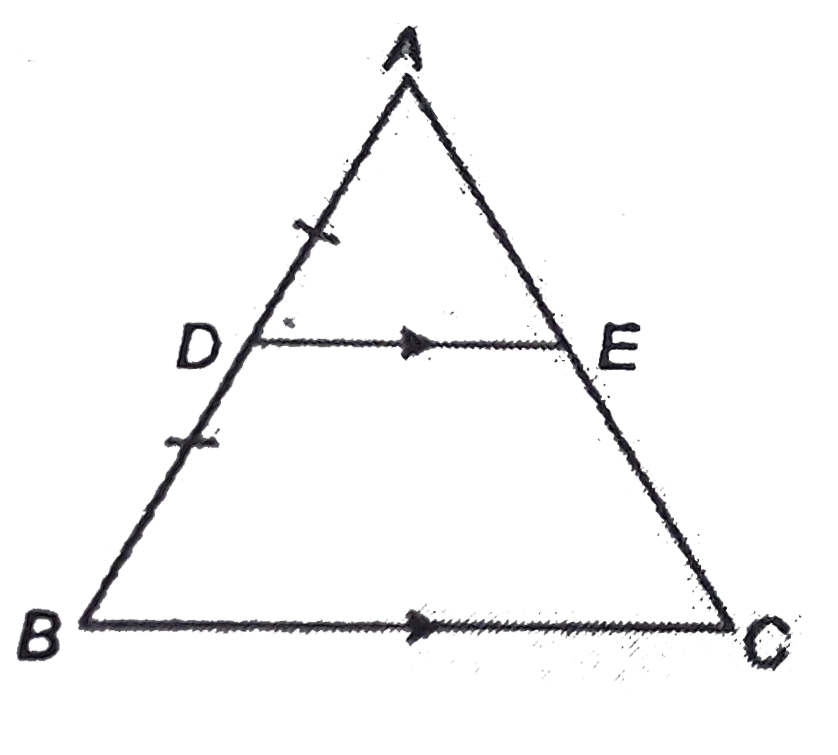A circle touches the hypotenuse of a right angled triangle at its middle point and passes through the mid-point of the shorter side. If aandb(a<b) be the lengths of the sides, then prove that the radius of the circle is b4a√a2+b2
To solve the problem, we need to prove that the radius r of the circle is given by the formula:
r=b4a√a2+b2
where a and b are the lengths of the sides of a right-angled triangle.
1. Understanding the Triangle Configuration:
- Let △ABC be a right-angled triangle with ∠C=90∘, where AB is the hypotenuse, AC=b (the longer side), and BC=a (the shorter side).
- The midpoint of the hypotenuse AB is denoted as D.
- The midpoint of the shorter side BC is denoted as E.
2. Establishing Coordinates:
- Place the triangle in the coordinate system:
- C(0,0)
- A(0,b)
- B(a,0)
- The coordinates of the midpoints are:
- D(a2,b2) (midpoint of hypotenuse)
- E(0,b2) (midpoint of shorter side)
3. Finding the Length of the Chord DE:
- The length of the chord DE can be calculated using the distance formula:
DE=√(a2−0)2+(b2−b2)2=√(a2)2=a2
4. Using Properties of the Circle:
- The line segment DE is a chord of the circle, and the radius r from the center O of the circle to the midpoint M of the chord DE is perpendicular to DE.
- Since D and E are midpoints, the length of DE is half of the length of the hypotenuse AB.
5. Finding the Radius:
- The radius r can also be expressed in terms of the angle α at vertex A:
- In triangle OME (where O is the center of the circle, M is the midpoint of DE, and E is the endpoint of the chord):
cosα=MEOE=r⋅cosαa2
- Rearranging gives:
r⋅cosα=a2
6. Using the Pythagorean Theorem:
- The hypotenuse AC can be expressed as:
AC=√a2+b2
- Thus, we can express cosα as:
cosα=b√a2+b2
7. Substituting Back:
- Substitute cosα back into the equation for r:
r⋅b√a2+b2=a2
- Rearranging gives:
r=a2⋅√a2+b2b
8. Final Expression:
- To express r in terms of b and a:
r=b4a√a2+b2
Conclusion:
Thus, we have proved that the radius r of the circle is given by:
r=b4a√a2+b2
- Let △ABC be a right-angled triangle with ∠C=90∘, where AB is the hypotenuse, AC=b (the longer side), and BC=a (the shorter side).
- The midpoint of the hypotenuse AB is denoted as D.
- The midpoint of the shorter side BC is denoted as E.
- Place the triangle in the coordinate system:
- C(0,0)
- A(0,b)
- B(a,0)
- The coordinates of the midpoints are:
- D(a2,b2) (midpoint of hypotenuse)
- E(0,b2) (midpoint of shorter side)
- The length of the chord DE can be calculated using the distance formula:
DE=√(a2−0)2+(b2−b2)2=√(a2)2=a2
- The line segment DE is a chord of the circle, and the radius r from the center O of the circle to the midpoint M of the chord DE is perpendicular to DE.
- Since D and E are midpoints, the length of DE is half of the length of the hypotenuse AB.
- The radius r can also be expressed in terms of the angle α at vertex A:
- In triangle OME (where O is the center of the circle, M is the midpoint of DE, and E is the endpoint of the chord):
cosα=MEOE=r⋅cosαa2
- Rearranging gives:
r⋅cosα=a2
- The hypotenuse AC can be expressed as:
AC=√a2+b2
- Thus, we can express cosα as:
cosα=b√a2+b2
- Substitute cosα back into the equation for r:
r⋅b√a2+b2=a2
- Rearranging gives:
r=a2⋅√a2+b2b
- To express r in terms of b and a:
r=b4a√a2+b2
Thus, we have proved that the radius r of the circle is given by:
Similar Questions
Knowledge Check
If length of hypotenuse of a right-angled triangle exceeds the length of one side by 2cm and exceeds twice the length of other side by 1cm, then the length of hypotenuse of the triangle is:
A17cmB1cmC15cmD22cm
Prove that the mid-point of the hypotenuse of right angled triangle is equidistant from its vertices.
View SolutionProve using similar triangles, that a line drawn through the mid-point of one side of a triangle parallel to another side, bisects the third side.

View SolutionThe line drawn through the mid-point of one side of a triangle, parallel to another side, intersects the third side at its mid-point.
View SolutionA circle touches two of the smaller sides of a ΔABC(a<b<c) and has its centre on the greater side. Then, find the radius of the circle.
View SolutionThe hypotenuse of a right angled triangle has its ends at the points (1, 3) and ( 4, 1) . Find the equation of the legs (perpendicular sides) of the triangle.
View SolutionThe hypotenuse of a right angled triangle has its ends at the points (1, 3) and ( −4, 1) . Find the equation of the legs (perpendicular sides) of the triangle.
View SolutionProve that the mid-point of the hypotenuse of a right triangle is equidistant from its vertices.
View Solution
